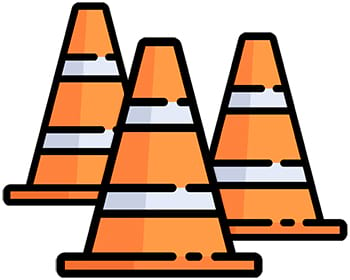Telehandler Training
Telehandler Training
Become Fully Licensed to Operate
At South Coast Forklift Training, our mission is to deliver top-notch telehandler training, producing highly skilled operators ready to apply their training in the workplace. We believe in challenging our trainees to bring out their best, and we achieve this by delivering our sessions in a relaxed and friendly atmosphere.
Course Highlights:
Our courses include classroom-based theory lessons and practical sessions using the telehandler truck. Following ITSSAR guidelines and the Health and Safety Commission’s Approved Code of Practice, we ensure employers meet their legal obligations to provide adequate training for all telehandler operators.
We use various techniques to cater to all learning preferences, including forklift models, videos, PowerPoint presentations, worksheets, and handouts. Theory work builds gradually, allowing time to absorb information before moving to the next stage. Practical lessons are demonstrated, and trainees are given ample time to practice under close supervision.
Why Choose Our Training?
We pride ourselves on our expert instructors and dedicated professionals with extensive experience. We offer flexible scheduling to fit your needs and provide certification recognised by employers upon successful completion.
Testing Stages:
- Theory Test: 25 questions with an 80% pass rate.
- Pre-use Inspection Test: Ensuring the truck is safe to use.
- Practical Skills Test: A timed and scored test involving various manoeuvres that must be completed safely.
While the word “test” can be intimidating, we are here to guide trainees through each section with support and encouragement.


The Telescopic Handler
Rugged and Versatile
A rough terrain telescopic handler, often shortened to telehandler, is a versatile truck that excels in off-roading across a farmer’s field, moving supplies on a construction site, or simply driving on the road.
Its name comes from its telescopic arm, a boom that extends upwards and outwards to collect or deposit a load. Telehandlers are often fitted with stabilisers to increase their capacity and stability when handling these loads.
These remarkable machines can be fitted with various attachments, including standard forks, buckets, scoops, grabs, cranes, hooks, and working platforms.
Telehandlers have large tyres and high ground clearance, and they come with three steering modes: two-wheel steer, four-wheel steer, and crab steer.
They come in various shapes and sizes. The largest models can reach over 20 metres, and the most powerful can lift more than 6 tonnes.
Operator comfort is a key design consideration. Since operators may spend an entire day in the cab, these trucks are equipped with heaters, air conditioning, height-adjustable seats and controls, USB sockets, and various storage compartments to enhance comfort.
Safety is paramount. Because telehandlers regularly work on steep slopes, the cabs are reinforced and fitted with load moment indicators to alert the operator when the truck is unstable.
Traditionally, telehandlers run on diesel, powered by an internal combustion engine. However, manufacturers have recently begun making hybrid and electric versions too.
TELEHANDLER TRAINING FROM A COMPANY THAT CARES
Telehandler Course Specifications

Machine:
Rough Terrain Telescopic Handler
Category:
J2
Specification:
Maximum 9 metre lift
Accrediting Body:
Independent Training Standards Scheme & Register (ITSSAR)
Maximum Ratio:
3 : 1 : 1 (3 operators, 1 instructor, 1 machine)
Duration:
Novice - 1 operator = 3 days, 2 operators = 4 days, 3 operators = 5 days
Experienced - 1 operator = 2 days, 2 operators = 2 days, 3 operators = 3 days
Safety Refresher - 1 operator = 1 day, 2 operators = 1 day, 3 operators = 1 day
Conversion - contact us
Cost:
Contact us
COURSES DESIGNED TO DELIVER RESULTS
Telehandler Course Breakdown
The following list is the elements that make up a novice telehandler course. For experienced operators, safety refresher and conversion courses the list would be shorter.
- Course induction
- The need and reasons for training and statutory requirements (HASAWA 1974 etc.)
- Introduction to equipment/control familiarisation/principles of operation
- Identification/use/adjustment of attachments in pre-determined positions including forks
- Recommended mount and dismount
- Introduction to motive, steering controls and practice
- Basic steering exercises – simple courses
- Advanced steering exercises – figure of 8/chicane/90° approaches
- Battery charging procedures/maintenance
- Operator safety code and relevant handout
- Daily pre-use inspections/refuelling procedures
- Engineering principles/rated capacity/stability
- Simple hydraulics (theory)
- Introduction to hydraulic controls, handling empty pallets low-level
- Load types/handling and weight assessment
- Stacking/de-stacking at low, medium and high levels on industrial racking*
- Stacking/de-stacking at low, medium and high levels bulk stacks*
- Stacking/de-stacking at low, medium and high levels cup post pallets*
- Manoeuvring with loads/ramps and inclines/handling awkward loads*
- Relevant safety film
- Vehicle loading and unloading (theory)*
- Vehicle loading and unloading (practical)*
- Multi-choice theory test
- Pre-use inspection test
- Practical skills test
* To be covered where relevant to operation or facilities permit
WHATEVER YOUR LEVEL, WE HAVE YOU COVERED
From in-depth beginners to safety refresher courses

ITSSAR-Accredited Telehandler Training
All courses are ITSSAR-accredited and recognised throughout the industry.

Novice Level Training
Trainees with little or no previous experience operating the relevant truck.

Experienced Level Training
Trainees with relevant, recent experience who have not received any approved training.

Safety Refresher Training
Periodic forklift refresher training for experienced operators who hold an accredited certificate.

Conversion Training
Training on a truck of a similar level to the one that the operator has already been trained, tested, and certified on.
Delivering the best for your business
Our courses are designed to achieve results
On-Site Telehandler Courses
Every telehandler course we deliver is carried out on our customer’s premises. This approach gives trainees the advantage of being trained and tested on a machine familiar to them, eliminating the need for re-learning on a different truck after the initial training. Upon completing this telehandler course, operators will know how to use these machines safely and efficiently.
We are pleased to offer bespoke training programmes tailored to your business requirements. We will always work around your needs and environment to minimise disruption.


Facilities Required
Firstly, and most importantly, we will need access to your telehandler to conduct your training. Additionally, we require an undisturbed area with ample space for basic manoeuvres and testing. Pallets and realistic loads appropriate to your business are useful; the instructor will provide traffic cones. For the theory lessons, sufficient space is needed for the instructor and trainees to work. A small office with a table, chairs, and power will suffice.
All truck operators must wear safety boots and other personal protective equipment per the company's internal risk assessments. We supply high-visibility vests.
If you have any questions or concerns about the above requirements, contact us to discuss them.
Telehandler Licence Certificates
After completing this telehandler training, drivers are fully licensed to operate in this category. The qualification is nationally recognised and accepted throughout the industry.
Participants will also receive the following:
- An A4 ITSSAR-approved telehandler certificate of basic training*
- A plastic photo identification card*
- A written assessment of strengths and weaknesses*
Additionally, operators are entered or edited onto ITSSAR’s TOPS (Trained Operator Passport Scheme) database for future reference.
\*There is no additional charge for these.


Five-Star Aftercare
Our service doesn't end with your training. At South Coast Forklift Training, we pride ourselves on our exceptional aftercare. This sets us apart from the competition and is one of the many reasons our clients return to us. We're always here to answer any questions and offer advice.
Additionally, after completing our training courses, clients receive:
- Warning when refresher training is due
- All relevant Health and Safety documentation
- Refuelling/recharging poster
- Seven-day pre-use inspection checklist
- Authorisation to operate lift trucks form
- Employer's training record form
Ready to Get Started?
Choose the ITSSAR-accredited training provider that will work with you to deliver high-quality telehandler training at your business premises.
Other Accredited Training Courses
Counterbalance Training
Counterbalance forklifts are the most common type of lift truck used today and are recognised for their versatility. They are essential for many industries and operate indoors and outdoors, making them highly practical for numerous material handling tasks.
Reach (Stand-On) Training
The reach (stand-on) truck is less common than the standard truck but offers similar manoeuvrability and functionality. In this case, the operator is seated instead of standing. These tiny-wheeled trucks are particularly suited for warehouses.
MLOP Training
The medium-level order picker is an electric-powered lifting and moving truck. The operator stands on a platform positioned in the centre or back. These machines are designed for efficient order picking at medium heights (up to 3 metres).
APPROVED FORKLIFT LICENCES AND CERTIFICATES
Quick Answers to Common Questions
If we haven’t covered all your questions already, please check out more frequently asked questions or contact us.
No wonder our clients keep coming back
Feedback from our trainees

"Helpful & informative. Confidence boosted, very personable."
GW, Portsmouth, Hampshire

"Good training at a relaxed pace. Great instructor, very knowledgeable and helpful."
JM, Chessington, Surrey

"Insightful and extremely informative with good use of desktop media."
FM, Liphook, Hampshire
⭐ Want to see more? Check out our Google reviews.
The Health and Safety at Work Act 1974
“It shall be the duty of every employer to ensure, so far as is reasonably practicable, the health, safety and welfare at work of all his employees.”







